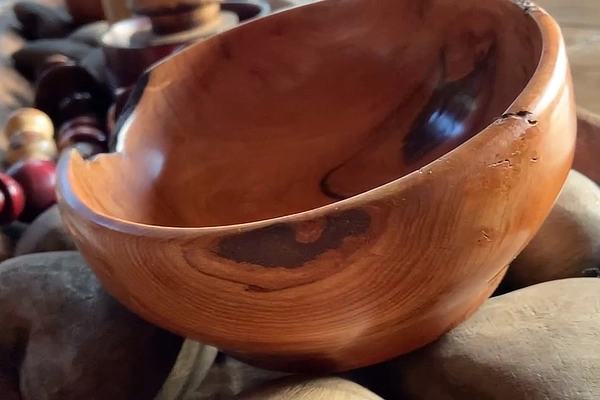
All my adult life, I have enjoyed watching others respond to works of art. Whether reacting to a painting, a symphony, or even a majestic mountain, it’s been clear to me for a long time that people perceive beauty in a multitude of ways, and it’s always an interesting opportunity for me to observe how different those responses can be.
Some of my compulsion comes naturally from within where I have had—since childhood—this drive to create. I have worked in the arts all my adult life, so crafting something with my hands—whether drafting a story or song, creating a musical moment, or just artistically setting an emotional tone in a space—all comes naturally to me. And, of course, I care about how others respond to my stuff.
Take a stump of wood, for instance. While some may see a bark-covered wood block as just a throwaway piece (or firewood), another could potentially see something quite different. A cabinetmaker may see that same block as something he could slice into boards for his work, while a tree trimmer might toss it into a chipper to create mulch without a second thought.
I see wood for what I might make of it. I see grain patterns, density, and color. My eyes go to a fork or a burl among the growth rings, and then I quickly segue to what this unwanted treasure could be if given the right opportunity. If I spot a tree up ahead while driving, I literally have my head on a swivel. As I get closer, I examine the leaves and bark to determine the type of tree, and then quickly devise a plan to retrieve a piece of it.
And the scent, oh my! Some varieties of wood are so aromatic that my whole shop carries a powerful essence while I work. I especially love old growth pine, sometimes called heart pine. I can drill into a plank that was harvested from a 100-year-old home and the powerful pitchy pine smell rolling up the drill bit makes me imagine that I am stepping back into history.
What makes wood a thing of beauty is not its perfection. On the contrary, it is the irregularities, or imperfections, that give every stick, block, plank or slab their individually crafted distinction. In some varieties of wood, a process called spalting is a byproduct of fungus that grows in a decaying tree. Beautiful bands of color and striations are formed from this breaking down process in the wood.
What about a knot? That dreaded blemish in an otherwise perfect plank is a sign that something grew from that spot! It only takes eyes to see beyond the surface to recognize that this knot is where a new branch was born—producing flowers, fruit, and even more branches.
Consider that wooden plank, and then consider the heart of humanity.
When Paul says in Philippians 3, “That I may know him and the power of His resurrection AND the fellowship of His suffering,” he was saying out loud that a relationship with the Man of Sorrows will mean that our walk will include pain, thorns, and imperfections.
When Paul says in 2 Corinthians 12:9, “I will boast all the more gladly in my weakness (imperfections) so that the power of Christ may rest upon me,” he is responding directly to the reassurance of Jesus’ words, “My grace is sufficient for you, for my power is made perfect in weakness.”
And should those struggles or wounds produce in you a limp, as they did with Jacob in Genesis 31, go with the words of Paul, “I press on toward the goal for the prize of the upward call of God in Christ Jesus.” (Philippians 3:14)
Your wounds, like those in that plank, are distinctions that when submitted to Christ and His plan, serve as beautiful markers for us and for those who have eyes to see that we are indeed His workmanship!
And the fragrance! Just like the powerful pitchy pine, 2 Corinthians 2:15 says it so clearly, “we are like a sweet-smelling incense offered by Christ to God …”
Let your wounds be your trophies and thank God, the master designer, that by his wounds, you have been set free. (Isaiah 53:5)
 Michael Adler has served the local church as a Worship Pastor for all of his adult life. After 22 years of leading the Worship Arts Ministry at Shades Mountain Baptist Church in Birmingham, he is now the Dean of the Worship Division of the Strength to Stand Institute with the Scott Dawson Evangelistic Association. He previously served at Castle Hills First Baptist in San Antonio as well as Bell Shoals Baptist in the Tampa area. With professional credits including TRUTH, Promise Keepers, the Billy Graham Association, LIFEWAY, the Texas Baptist Convention, the Southern Baptist Convention, and the California Baptist Convention, he is also a published composer, arranger, and clinician. Michael has served in an advisory capacity and guest teacher for several Christian universities and seminaries in the areas of worship leadership and the local church, and regularly coaches worship leaders and teams in practical tools for effective and long-term ministry.
Michael Adler has served the local church as a Worship Pastor for all of his adult life. After 22 years of leading the Worship Arts Ministry at Shades Mountain Baptist Church in Birmingham, he is now the Dean of the Worship Division of the Strength to Stand Institute with the Scott Dawson Evangelistic Association. He previously served at Castle Hills First Baptist in San Antonio as well as Bell Shoals Baptist in the Tampa area. With professional credits including TRUTH, Promise Keepers, the Billy Graham Association, LIFEWAY, the Texas Baptist Convention, the Southern Baptist Convention, and the California Baptist Convention, he is also a published composer, arranger, and clinician. Michael has served in an advisory capacity and guest teacher for several Christian universities and seminaries in the areas of worship leadership and the local church, and regularly coaches worship leaders and teams in practical tools for effective and long-term ministry.
Outside of the promise of eternal life, Michael considers his greatest gift to be his wife, Linda, a professional vocal coach whom he met while recording daily television shows and specials with the Oral Roberts television ministry in the 80s. Together they have four sons and a growing list of wonderful daughters in law and live on 8 gorgeous acres just outside of Birmingham. There they own and operate the premiere wedding venue, The Barn at Shady Lane.
